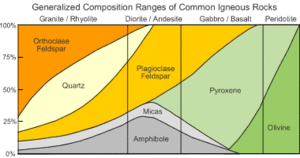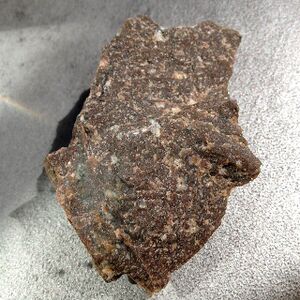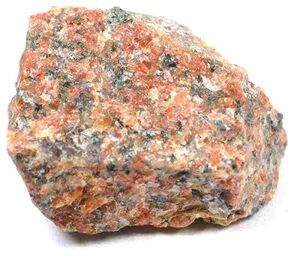Granite
Granite is a coarse-grained intrusive igneous rock. Granite consist of quartz and plagioclase feldspar which gives its red, pink, gray, or white color with dark mineral grains visible throughout the rock. Granite forms from granitic magma in continental or continent-margin deep in the crust. Granite can be brought up by uplifting or erosion of overlying rocks. Granite is the intrusive version of rhyolite.
Characteristics
 Granite is a coarse-grained, light-colored igneous rock composed mainly of feldspars and quartz; it also contains minor amounts of mica and amphibole minerals. A more detailed description can be found in the chart on the right.
Granite is a coarse-grained, light-colored igneous rock composed mainly of feldspars and quartz; it also contains minor amounts of mica and amphibole minerals. A more detailed description can be found in the chart on the right.
Feldspar Minerals
Feldspar minerals are abundant in granite. They are usually white, gray, pink or reddish in color. Many grains will exhibit two directions of cleavage that intersect at right angles. You should be able to observe this cleavage pattern in granite with a hand lens.
Quartz
Quartz will usually be a transparent mineral that is colorless or gray in color. Many grains will exhibit a conchoidal fracture - with a vitreous luster on the conchoidal fracture surfaces.
Mica Minerals
The mica minerals expected in granites include muscovite or biotite. Micas occur in very thin sheets. They will often be in "books" of numerous sheets stacked upon one another. The surfaces of these sheets will have a highly reflective vitreous luster. The edges of a "stack of sheets" will look similar to the edge of a stack of playing cards.
Amphibole Minerals
Amphibole minerals such as hornblende are dark in color and will often have a prismatic habit.
Microgranite
 Microgranite is a medium-grained intrusive igneous rock. It contains crystals, smaller than grains of rice, which are interlocking and randomly oriented. It is pale grey and can sometimes be pinkish in color.
Microgranite is a medium-grained intrusive igneous rock. It contains crystals, smaller than grains of rice, which are interlocking and randomly oriented. It is pale grey and can sometimes be pinkish in color.
It contains a number of minerals, mostly feldspars, which are pale grey or pinkish, and quartz, which is grey or white. It also contains small specs of mafic minerals.
Microgranite is the medium-grained equivalent of granite. The crystals are slightly smaller than granite indicating that the magma cooled more quickly. It usually occurs in smaller intrusions than granite. Microgranite forms from magma that contains a lot of quartz.
References
Granite

| Type | Intrusive igneous rock |
|---|---|
| Clasts | Coarse grained |
| Hardness | Very hard |
| Color | Red, pink, gray, or white with dark mineral grains visible throughout the rock. |
| Minerals | Quartz and plagioclase feldspar |
| Touch | Rough |
| Image | Granite |